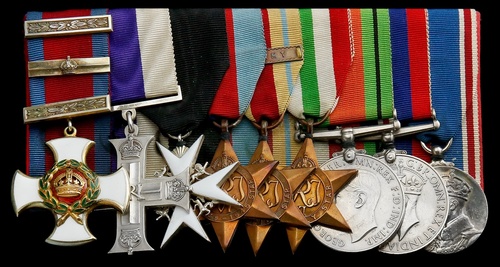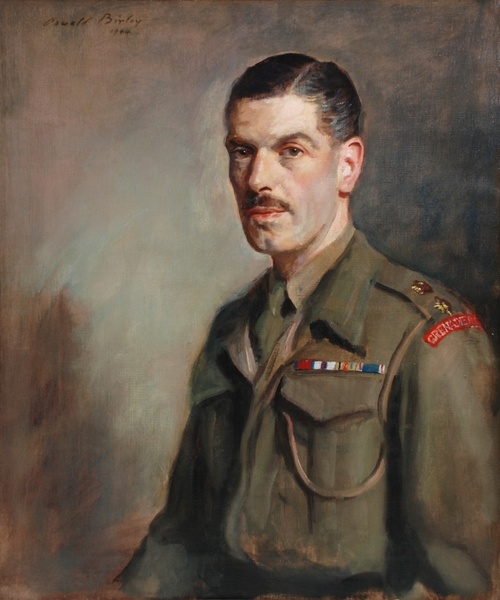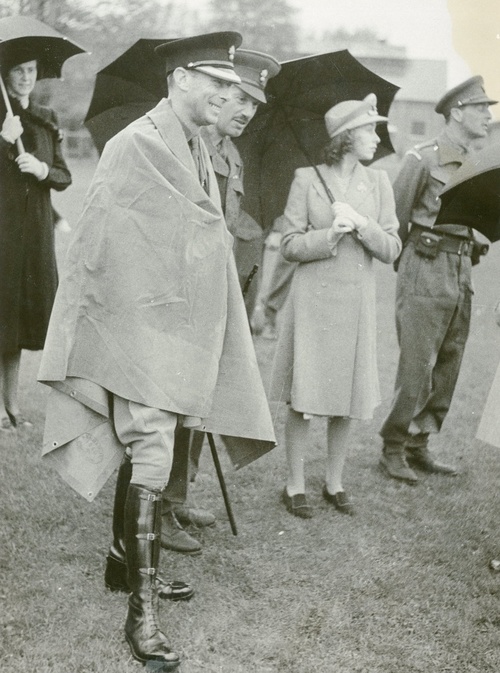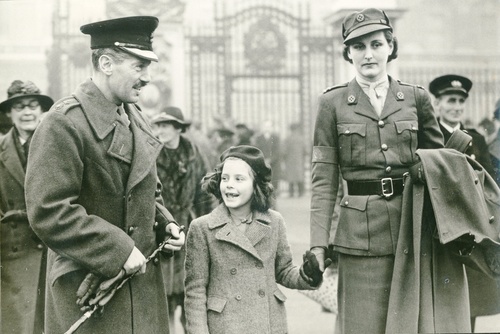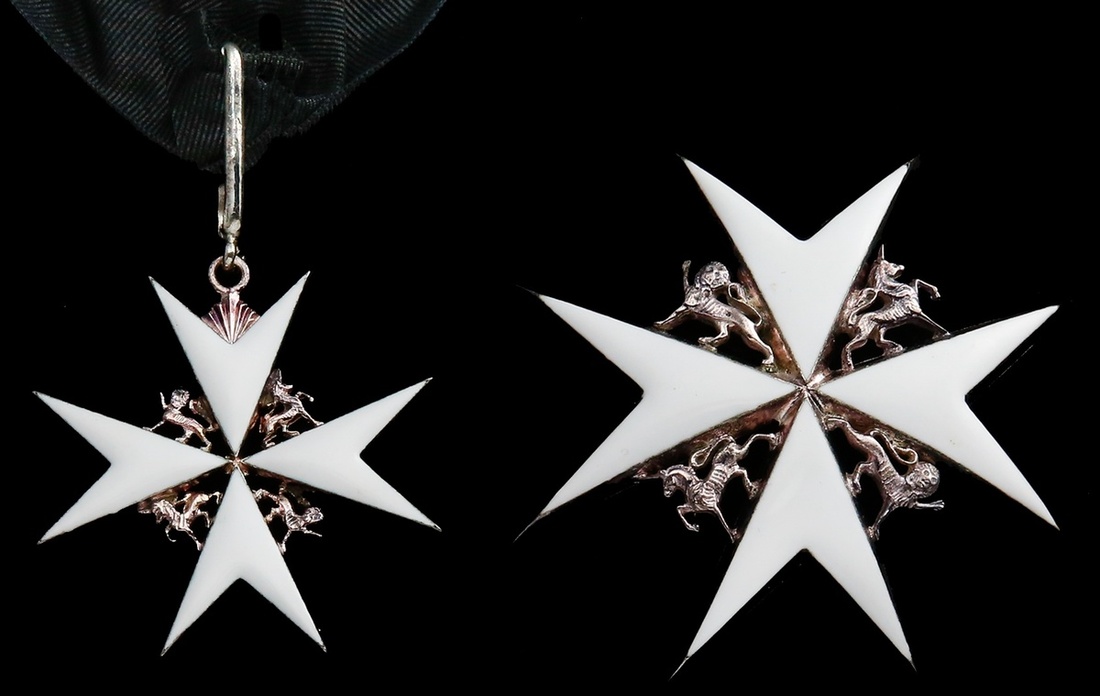Auction: 17003 - Orders, Decorations and Medals
Lot: 702
Sold by Order of a Direct Descendant
'A splinter caught him on the chin and cut it rather deeply and knocked three of his teeth out … He was absolutely magnificent and an inspiration to the whole Battalion. Completely devoid of fear he was always where the battle was most severe, cool as a cucumber and a real "leader" of men … '
Major B. Kingsmill, 6th Grenadiers, in a letter to Lady Clive, the mother of Brigadier A. F. L. Clive, D.S.O., M.C., following the horrific action at 'Horseshoe' in the North Africa in March 1943.
'I still feel that there is nothing to touch the Horseshoe Battle for its record of sheer courage and tragedy.'
Nigel Nicolson, in a letter to Brigadier Clive; he co-authored the history of The Grenadier Guards in the War of 1939-1945 with Patrick Forbes (1949).
The outstanding K. St. J., Second Word War North Africa and Italy operations D.S.O. and Bar, Fall of France M.C. group of eleven awarded to Hon. Brigadier A. F. L. Clive, Grenadier Guards
Having won an impressive M.C. in the retreat to Dunkirk in May 1940, he was appointed to the command of the 6th Battalion and won an immediate D.S.O. for 'magnificent courage' - and a quite stunning display of leadership - at the 'Horseshoe' feature in North Africa in March 1943: in writing home to his wife from hospital, he spoke of 'the father and mother of a battle' but made light of his battered face and smashed teeth
His second immediate D.S.O. reflected equal powers of leadership as C.O. of 24th Guards Brigade in Italy in October 1944 where, once again, his extraordinary valour and personal example changed the tide of battle:
'His appearance at the forward positions during the periods of the heaviest fighting proved of critical value in producing valiant efforts from his battalions, with the result that the position was taken and held in spite of repeated counter-attacks, during which Brigadier Clive's example held the troops firm and encouraged them to inflict heavy casualties on the enemy … '
A Grenadier to his fingertips, the Brigadier's forceful character was pleasingly balanced by his great charm and a mischievous sense of humour: 'In peace, as in war, he was a leader who was loved and respected by all with whom he came into contact'
The Order of St. John (K. St. J.), Knight's set of insignia, comprising neck badge and breast star, silvered-metal and enamel, in case of issue, together with his earlier Commander's and Officer's badges; Distinguished Service Order, G.VI.R., silver-gilt and enamel, with Second Award Bar, the reverse of the suspension bar officially dated '1943' and the reverse of the Bar officially dated '1945'; Military Cross, G.VI.R., the reverse officially dated '1940'; 1939-45 Star; Africa Star, clasp, 8th Army; Italy Star; Defence and War Medals 1939-45; Coronation 1937, privately engraved, 'Capt. A. F. L. Clive, 3rd G. Gds.', mounted court-style as worn where applicable, together with another, G.VI.R. Military Cross, undated, the reverse privately engraved 'Major A. F. L. Clive, Carvin, 26 May 1940', this with a metalled lady's riband bow fitment for wearing, generally good very fine (11)
D.S.O. London Gazette 22 July 1943. The original recommendation for an immediate award approved by Montgomery - states:
'Lieutenant-Colonel Clive was commanding the 6th Battalion, Grenadier Guards during the attack of 201 Guards on the HORSESHOE feature on 16 March 1943. During the early stages of the attack the Battalion encountered unexpected and extensive anti-personnel minefields, which showed signs of disorganising the attack. Lieutenant-Colonel Clive visited each company in turn and by his personal bravery and example ensured the capture by each company of its objective.
For the remainder of the night he moved about his battalion area showing complete unconcern for his personal safety, reorganising his position with such skill and energy that two German counter-attacks were beaten off with heavy loss to the enemy. By morning the enemy had succeeded by working round the flanks, in getting in rear of the Battalion, and Colonel Clive was ordered to withdraw.
This most difficult daylight operation was organised and carried out by Colonel Clive under heavy and accurate fire, by which he was eventually wounded.
His magnificent courage, great powers of leadership and complete coolness under the most difficult circumstances provided the inspiration which enabled his battalion, which was taking part in its first battle, to capture and hold its objective, in spite of heavy casualties. It was only by showing a complete disregard for the enemy's fire that he was able to organise the withdrawal.
His personal courage, his coolness under the most difficult circumstances, and his disregard of danger was an example and inspiration to all ranks of his battalion.'
Bar to D.S.O London Gazette 8 February 1945. The original recommendation - for an immediate award approved by Alexander - states:
'For gallant and distinguished leadership in action against the enemy.
In order for the Division to continue its advance, it was vital for 24 Guards Brigade to break the enemy defences at Point 707 during the operations of 1-3 October 1944. This position was strongly held by an entrenched enemy. During the initial attack by 1st Scots Guards, Brigadier Clive, by his personal courage and leadership, under heavy shell-fire and the most trying weather conditions, inspired all under his command.
At the most critical stage of the operations, Brigadier Clive boldly committed 5th Grenadier Guards against the reinforced enemy. Here again, his appearance at the forward positions during the periods of the heaviest fighting proved of critical value in producing valiant efforts from his battalions, with the result that the position was taken and held in spite of repeated counter-attacks, during which Brigadier Clive's example held the troops firm and encouraged them to inflict heavy casualties on the enemy.'
M.C. London Gazette 11 July 1940. The original recommendation states:
'Major Clive showed great courage and coolness on 26 May [1940] at Camphin, when sent to deal with a critical situation which had arisen through the withdrawal of the 8th Durham Light Infantry. He assisted the C.O. to reorganise the Battalion and to counter-attack and recapture Carvin. The successful result of the operation was due to a great extent to Major Clive's example and leadership.'
Arthur Francis Lawrence Clive was born in London on 24 June 1903, the son of Lieutenant-General Sir George Sidney Clive, G.C.V.O., K.C.B., C.M.G., D.S.O., a descendant of Clive of India, and his wife, Madeline Buxton.
Flirting with Nancy Mitford - no gong
Educated at Harrow and the R.M.C. Sandhurst, Arthur was commissioned in his father's old regiment, the Grenadier Guards, in February 1923. As a young officer about town, he appears to have caught Nancy Mitford's admiring eye. He makes an appearance in her collected letters and biographies, following a meeting in Scotland in 1927:
'[Nancy] was saved from complete despair by the presence of Archer Clive, a handsome young Grenadier Guards officer from Herefordshire who with his sister Mary were allies in the war between aesthete and hearty. Both were lively and agreeable, occasionally read books, and Archer's half-flirtatious banter Nancy found immensely exhilarating. "Archer is being too beastly," she wrote delightedly to Tom [her brother], "he never spoke to me yesterday except to say he'd like to bang my head on the floor & the day before he said among other acid remarks that if it weren't for my extraordinary ideas and my men friends I should be quite nice." Unfortunately, after a few days the Clives left to be replaced by "Two perfectly dire people … I am miserable because the Clives (who I adore really) have gone." '
There would appear to have been further encounters with Mitford, so much so that some of her biographers have speculated that she may have ended up as Clive's wife. But it wasn't to be, for he married Penelope Portman, daughter of Viscount Portman, in 1934; the marriage was not a success and they divorced in 1949.
Shortly after his Scottish encounter with Nancy Mitford, Clive was attached to the Sudan Defence Force, a memorable appointment recorded in an accompanying archive of letters and photographs. He was promoted to Captain on his return home and gained a private pilot's licence in the summer of 1930.
France 1940: M.C.
On the outbreak of hostilities in September 1939, Clive was advanced to Major and joined the B.E.F. in France.
From March 1940 he served as Brigade Major to the 151st Infantry Brigade and it was in this capacity that he won his M.C. at Carvin at the end of May.
The history of the 8th Battalion, Durham Light Infantry, which unit he rallied, speaks of its advance being made under constant shelling and bombing but with 'great elan … which had a marked effect on all the Allied troops in the area': by facing-off subsequent enemy counter-attacks, Clive's and the Durhams' gallant work won vital time for the retreat to Dunkirk, about 100 km. to the north-west from Carvin.
Following his gallant deeds in France, and escape from Dunkirk, Clive held a spate of staff appointments. In 1941, however, he was given command of the 6th (Motor) Battalion, Grenadier Guards, a component of 201st Guards Brigade, which was commanded by his cousin, Sir Julian Gascoigne. It was an inspired choice.
Following the death of the Colonel of the Regiment, H.R.H. Duke of Connaught, H.R.H The Princess Elizabeth became the new Colonel of the Regiment and, in May 1942, she honoured Clive's 6th Battalion by carrying out her first inspection of the Grenadiers.
North Africa: immediate D.S.O.
The 6th Battalion embarked for the Middle East a few weeks later, where, as cited above, Clive won fame for his exemplary leadership and courage in the desperate battle fought at the 'Horseshoe' feature on 16 March 1943.
Guarding as it did the approaches to Rommel's main defences on the Mareth Line, 'Horseshoe' was to play a pivotal role in Montgomery's ambitions, although by way of a diversionary attack in support of the New Zealand Division. Unfortunately for Clive and his men, the enemy had captured a detailed plan of his unit's attack 48 hours before the 'off' and the approaches of the attack were swiftly sown with thousands of mines. Montgomery, who had visited the 6th Battalion in his converted 'Honey' tank a few days before the action, was apparently aware of this serious loss but, it has been said, opted to risk the battalion 'rather than lose than a Division.'
What followed was considered by many to be one of the finest actions fought by the Grenadiers in the war. It was certainly one of the bloodiest, Clive and his men displaying Herculean courage against the elite ranks of Rommel's 90th Light Division. The Battalion's resultant casualties were shocking in the extreme: in a single night it lost 16 officers killed, five wounded and five taken prisoner, and 76 other ranks killed, 109 wounded and three taken prisoner. Clive was among the former, having taken a shell splinter in the face.
In writing home on 22 March 1943, Clive described to his wife how he and his men 'had the father and mother of a battle with the Boche':
'The Battalion fought quite magnificently and captured all of its objectives, but alas, owing to acres of mines, etc. I couldn't get support weapons up to the companies which were duly surrounded and ordered to fight it out which they did, but at terribly heavy cost as you will have heard … '
On recovery from his wounds, he served as a G.S.O 1 with 203 Military Mission in the period August 1943 to February 1944.
Italy: immediate Bar to D.S.O.
Clive was subsequently appointed to the command of 24th Guards Brigade, a component of 6th (S.A.) Armoured Division, in Italy, in which role he returned to the fray in typically gallant fashion.
That gallantry was evident throughout the Brigade's advance on Rome and Florence and, from August 1944, in a series of bitter actions on the Gothic Line. Most memorable of those actions was 24th Guards Brigade assault on Catarelto Ridge in early October 1944 when, once again, Clive's courage and leadership proved inspirational in the face of what was described as the 'fanatical resistance' of S.S. troops.
According to the official history of the 6th (S.A.) Armoured Division:
'Enemy machine-gun fire was heavy, but attempts by the S.S. troops to infiltrate during the night of 1-2 October 1944 were beaten off. With the 1st Battalion, Scots Guards having been badly knocked about, 5th Battalion, Grenadier Guards were ordered to storm Mt. Catarelto on 2 October 1944. The attack was delivered in thick mist and blinding rain, and although the attacking troops got within 50 yards of the crest, the Germans refused to be dislodged. Twice the leading company attempted to storm the crest, and twice they were beaten off. The thick mist greatly restricted supporting fire, and it was decided to call off the attack pending an improvement in the weather … Plans were made to resume the assault on 3 October 1944, but during the night of 2-3 October 1944 a Grenadier Guards patrol reached the crest of Catarelto and found that the Germans had withdrawn. The Germans had fallen back along the whole brigade front and 3rd Battalion, Coldstream Guards completed the occupation.'
It was amidst this mist and machine-gun fire that the gallant Brigadier moved around his men:
'During the initial attack by 1st Scots Guards, Brigadier Clive, by his personal courage and leadership, under heavy shell-fire and the most trying weather conditions, inspired all under his command.
At the most critical stage of the operations, Brigadier Clive boldly committed 5th Grenadier Guards against the reinforced enemy. Here again, his appearance at the forward positions during the periods of the heaviest fighting proved of critical value in producing valiant efforts from his battalions, with the result that the position was taken and held in spite of repeated counter-attacks, during which Brigadier Clive's example held the troops firm and encouraged them to inflict heavy casualties on the enemy.'
Clive and his Brigade afterwards liberated Trieste and, in the aftermath of the war, he commanded the Military Mission to South Africa and a T.A. Infantry Brigade.
Postscript - K. St. J
On retiring from the Army in 1947, the Brigadier settled at Grendon Court, Ross-on-Wye, nearby his father's estate, Perrystone Court, which fronted onto an avenue of pines planted in 1815 to commemorate Waterloo.
Over the ensuing decades he devoted his energy to public duties, among them service as a J.P. (1953) and D.L. for Herefordshire (1960). His renowned of powers of leadership were likewise directed to other good causes and he was appointed a Knight of the Order of St. John in July 1985; he had earlier been appointed an Officer (1966) and Commander (1971) of the Order.
The Brigadier, who 'was endowed with great charm', died at Ross-on-Wye, Herefordshire in March 1995, aged 91. Following his divorce from Penelope Isobel, daughter of Viscount Portman, he married, secondly, Olivia Mary, daughter of Lieutenant-Colonel the Hon. Frederick Stanley.
To be sold with an impressive archive of original documentation and photographs, including:
(i)
The recipient's D.S.O. warrant, in the name of 'Major (Temporary Lieutenant-Colonel) A. F. L. Clive, M.C., Grenadier Guards', dated 22 July 1943.
(ii)
Warrant appointing him a Deputy Lieutenant, in the name of 'Arthur Francis Lawrence Clive, D.S.O., M.C., of Grendon Court, Ross-on-Wye', dated 24 May 1960.
(iii)
The Armorial Bearings of Arthur Francis Lawrence Clive Esquire, D.S.O. & Bar, M.C., certificate presented by the York Herald, instructed by the College of Arms, London, framed and mounted behind glass; together with The Armorial Bearings of Arthur Francis Lawrence Clive, Captain, Grenadier Guards, and of Penelope Isobel his wife, daughter of The Honble. Gerald Berkeley Portman, sometime Captain, 10th Hussars.
(iv)
Federation Aeronautique Internationale, British Empire, Aviator's Certificate, No. 9254, in the recipient's name and dated 26 June 1930, with portrait photograph; together with his Driver's Licence for the Province of Transvaal, No. 3412, in the name of 'Lt. Col. A. Clive', issued 12 May 1941, with portrait photograph; and three passport-sized photographs in a leather wallet.
(v)
An impressive archive of letters from the Sudan, 1928-1930, contained in Ryman clip file, commencing with a letter to his mother sent on 13 May 1928, from the S.S. Gloucestershire, sharing a host of stories detailing his travels to Marseilles and on to Port Said. He seems anxious for adventure and notes 'Life in the ship is very dull. We play the usual games, deck tennis, skittles, etc., but the amount of eating and sleeping done is enormous!' Days later, his second letter varies in topic from an inability to get into his father's white duck trousers through to the tale of a woman who drowned on board in her bath. He is appalled by the heat and entertained by insect and animal life - 'A swarm of locusts came into the ship this morning - horrible beasts they are too. There are also lots of porpoises and one or two sharks about and visible.' His third letter announces his arrival at Port Sudan and the continual terrific heat - 'Whisky tastes like nectar of the most marvellous kind although it is probably quite warm!' His next letters are from the Sudan Club, Khartoum, and continue to describe life as he finds his feet and adapts like everyone else to wearing white or cream clothing; when addressing his father, his letters move to the practicalities of life - 'Would you please send me not one, but two, cheap Ingersol watches, they cost £2.10. out here and one's servants and grooms are a continual nuisance with their excuses for absence.'
The letters continue from 30 June 1928 to 26 February 1930, on nearly a weekly basis, written with considerable flair and description. The 'old camel mail' as he describes the postal service, gives him an opportunity to communicate with home in a way which is full of good humour and charm, despite the continual deprivations of isolation and harsh environment.
The file concludes with an account of a camel trek hunting expedition from Fasher to Nyala, including some fascinating insights into the hostility of the environment and, in particular, his issues with the camels and mosquitos. At Dirra he tried his hand with a 'bow and poisoned arrows from Nigeria,' but seems heavily hindered by the hornets and other insects - 'Ticks awful, couldn't walk a yard without them swarming up one's legs.' He reverts to his rifle and bags a partridge for luncheon. Days later, at Wadi Fadwa, he notes 'A most disturbed night; Lions, Jackals and Hyenas wandered round the camp, making awful noises and woke me at midnight. The fire was out (I had only had one built), and I was nervous that the donkey or horse might be taken at any minute … '
(vi)
An outstanding photograph album, in red morocco leather with gold tooled initials 'A.F.L.C.' and additionally marked to front 'Sudan' and '1928', and containing approximately 300 images. The album commences with a map of Sudan displaying the road and rail networks, branching rivers and emerging settlements. It then commences with a large number of annotated photographs, showing key sites such as the Suez Canal, the Bitter Lakes, Ali Dinar's Palace, and the Governor's House at El Fasher. There follow numerous shots of the Sudanese people, daily life in Sudan including wedding and dance photographs, and images of hunting expeditions for buffalo and even a giant vulture. These are followed by outstanding group shots of fellow officers and images of No. 6 Mounted Infantry Company on manoeuvres at Buram, 1929. The images then focus further upon the Camel Company, before returning to some outstanding pictures of local people and family members holding baby cheetahs and leopards. The album ends with an attention to the local units, in particular the Machine Gun Sections and the local native police playing the bagpipes. A rare and impressive record of life in the Sudan 1928-30.
(vii)
A fine selection of photographs, including full-length portrait as a young man, in uniform of the Grenadier Guards, together with his father in full regalia, by Speaight Ltd., 157 New Bond Street; further image by Vandyk, in officer's attire; a framed and glazed photograph of the Warrant Officers and Sergeants of the 2nd Battalion, Grenadiers, 1934, with presentation plaque to Clive on his leaving the unit in 1934; formal portrait photograph mid-way through the war, displaying M.C. riband; reproduction image of an original oil portrait of him by the famous society artist Sir Oswald Birley, dated 1944; an investiture image showing him with his wife and daughter outside the gates of Buckingham Palace, labelled to reverse 'A recent Investiture at Buckingham Palace, 31331. Lt. Col. Archer Clive, D.S.O., M.C., Grenadier Guards, with Mrs. Clive of the M.T.C. and their daughter Sally'; War Office photograph displaying Clive chatting to King George VI, with a young Princess Elizabeth to his left, labelled to the reverse, 'British Official Photograph (Picture issued June 1942), Colonel the Princess Elizabeth visits her Grenadier Guards Regiment. Princess Elizabeth, Colonel-in-Chief of the Regiment inspected a battalion of the Grenadier Guards in the South-Eastern Command. The King and Queen were with her. Princess Elizabeth wore the regimental badge on her hat. Picture shows: The King and Princess Elizabeth protected from the rain during a shower'; and a framed and glazed 50th Anniversary photograph of some of the survivors of the 6th Battalion from the 'Horseshoe' action on the Mareth Line, taken at the Guards Depot, Pirbright, 16 March 1993.
(viii)
Field Message Army Book 153, annotated twice on the inside covers with his signature and '2nd Bn. Grenadier Guards.' A detailed series of pencil notes advocating the practicalities of the Advanced Guard, outpost defence in depth, patrol organisation and mirror tactics.
(ix)
The recipient's 'Personal and Secret' annotated manuscript documents relating to the training his men, through to the reconnoitring of the battlefields of North Africa, with details concerning army strength, transfer of fellow officers and information regarding sickness rates and the disposition of the Officers; together with extracts from messages received, including one from Montgomery - 'I learn that the Grenadiers and Coldstreams fought magnificently and killed many Germans - operation on the night 16th-17th March, as a whole, was a great success. We got the ground we must have for the big blow. Your operations that night definitely helped the army plan - Tell the troops this'; and extracts from a letter written by the doctor attached to the 2nd Battalion, Coldstream Guards, 22 May 1943 - 'War wounds can be more horrible than I had ever conceived. I was blown up by a mortar bomb myself at Sbiba and miraculously had nothing more than a hole in my boot and a bruised bottom! Tank wounds and Stuka wounds are on the other hand ghastly … '
(x)
A selection of wartime letters and reports in respect of the 'Horseshoe' action in March 1943, including one from a fellow officer - 'I wish you could have been here to have heard all the wonderful things which have been said about the conduct of the Battalion in the attack. Gunners - Sappers - other infantry units, as well as Generals Erskine and Horrocks have all said that it was the finest show that has ever been put up, and all of them who know you want to be remembered to you'; a letter from the recipient to his wife, dated 22 March 1943 - 'Some days ago we had the father and mother of a battle with the Boche. The Bn. fought quite magnificently and captured all its objectives, but alas, owing to acres of mines, etc. I couldn't get support weapons up to the companies which were duly surrounded and ordered to fight it out which they did, but at terribly heavy cost as you will have heard'; accompanying list of those wounded, with a further typed list titled 'Officer and Other Ranks Buried at Horseshoe Cemetery'; a typed letter from Major B. Kingsmill to Lady Clive, the recipient's mother, dated 19 March 1943 - 'A splinter caught him on the chin and cut it rather deeply and knocked three of his teeth out … He was absolutely magnificent and an inspiration to the whole battalion. Completely devoid of fear he was always where the battle was most severe, cool as a cucumber and a real "leader" of men'; and further copies or extracts from letters regarding the 'Horseshoe' battle, together with poignant references to those killed, among them the son of Lord Trenchard.
(xi)
A letter from regimental historian Nigel Nicolson, formerly a Captain in the Grenadier Guards, to Clive, requesting that he look over the chapters of the 6th Battalion Regimental History, in particular the 'Horseshoe Battle' and the last phase of the Tunisian Campaign - 'If you could find time to read them through, I should much appreciate your comments'. He goes on to state - 'I still feel that there is nothing to touch the 'Horseshoe Battle' for its record of sheer courage and tragedy.'
(xii)
Regimental manuscripts (12), marked 'Confidential', dated from 1941-1945, detailing major events and recommendations, together with correspondence with his wife regarding her husband and progression of the war in North Africa; a Roll of Honour for the 6th Battalion, Grenadier Guards, together with Nominal Roll of Officers' Next of Kin for the 6th (Motor) Battalion, Grenadier Guards; together with note by Clive written on blue notepaper titled 'Beware of These!', being a copy of a memorandum by the Commander-in-Chief of the German Army. It reads: 'I divide my Officers into four classes as follows: the Clever, the Industrious, the Lazy, the Stupid. Each Officer always possesses two of these qualities. But whosoever is stupid and industrious must be got rid of, for he is very dangerous.'
(xiii)
Books (3), Standing Orders for the Brigade of Guards, London, W. Clowes & Sons, 1905; Standing Orders of the Guards Depot, Gale and Polden Ltd., 1931; Regimental Standing Orders, Grenadier Guards, The Army & Navy Stores, Ltd., 1939.
(xiv)
Order of Service for the Funeral of Brigadier Archer Francis Lawrence Clive, 1903-1995, held at The Parish Church of St. Mary Foy, Herefordshire, Thursday, 6 April 1995 and Regimental Remembrance Day Service Booklet, Guards Chapel, Wellington Barracks, 21 May 1995.
(xv)
Purple silk wallet, monogrammed to centre with intricate gold thread and with thread borders.
(xvi)
Pennant of the 'Adjutant, 2 Bn. Gren. Gds.', original cotton pennant, minor holing and fading
Please see Lot 640 for the recipient's miniature dress medals.
Subject to 20% VAT on Buyer’s Premium. For more information please view Terms and Conditions for Buyers.
Sold for
£6,200

